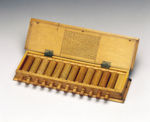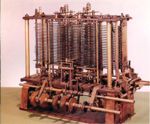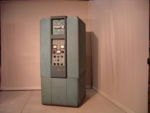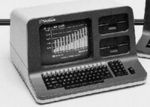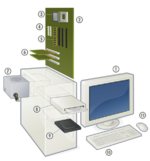Computer: Development of Computer
Computer: Development of Computer
Introduction
For most people, a computer is a machine used for calculation or computation, but actually, it is much more than that. PreciselyComputer is an electronic device for performing arithmetic and logical operation. Or “Computer is a device or a flexible machine to process data and converts it into information.”
To know about the complete process that how a computer works, we will have to come across various terms such as Data, Processing, and Information. First of all, we will have to understand these terms in the true sense.
1.DATA: – “Data” is nothing but a mare collection of basic facts and figures without any sequence. When the data is collected as facts and figures, it has no meaning at that time, for example, name of the student, names of employees, etc.
2.PROCESSING: – ‘Processing’ is the set of instructions given by the user or the related data to output the meaningful information. Which can be used by the user? The work of processing may be the calculation, comparisons, or the decision taken by the computer.
3.INFORMATION: – ‘Information ’is the endpoint or the final output of any processed work. When the output data is meaning it is called information.
Development of Computer
The computer as we know it today had its beginning with a 19th-century English mathematics professor name Charles Babbage.
He designed the Analytical Engine and it was this design that the basic framework of the computers of today are based on.
Generally speaking, computers can be classified into three generations. Each generation lasted for a certain period of
time and each gave us either a new and improved computer or an improvement to the existing computer.
First-generation: 1937 – 1946 – In 1937 the first electronic digital computer was built by Dr. John V. Atanasoff and Clifford Berry. It was called the Atanasoff-Berry Computer (ABC). In 1943 an electronic computer name the Colossus was built for the military. Other developments continued until 1946 the first general-purpose digital computer, the Electronic Numerical Integrator and Computer (ENIAC) were built. It is said that this computer weighed 30 tons, and had 18,000 vacuum tubes that were used for processing. When this computer was turned on for the first time lights dim in sections of Philadelphia. Computers of this generation could only perform a single task, and they had no operating system.
Second generation: 1947 – 1962 – This generation of computers used transistors instead of vacuum tubes which were more reliable. In 1951 the first computer for commercial use was introduced to the public; the Universal Automatic Computer (UNIVAC 1). In 1953 the International Business Machine (IBM) 650 and 700 series computers made their mark in the computer world. During this generation of computers over 100 computer programming languages were developed, computers had memory and operating systems. Storage media such as tape and disk were in use also were printers for output.
Third generation: 1963 – present – The invention of the integrated circuit brought us the third generation of computers. With this invention computers became smaller, more powerful more reliable and they can run many different programs at the same time. In1980 Microsoft Disk Operating System (MS-Dos) was born and in 1981 IBM introduced the personal computer (PC) for home and office use. Three years later Apple gave us the Macintosh computer with its icon-driven interface and the 90s gave us Windows operating system.
As a result of the various improvements to the development of the computer, we have seen the computer being used in all areas of life. It is a very useful tool that will continue to experience new development as time passes.
Let’s start with the details:
THE ABACUS
Abacus is known to be the first mechanical calculating device. Which was used to be performed addition and subtraction easily and speedily? This device was first developed Ed by the Egyptians in the 10th century B.C, but it was given its final shape in the 12th century A.D. by the Chinese educationists. Abacus is made up of a wooden frame in which rods were fitted across with rounds beads sliding on the rod. It is dividing into two parts called ‘Heaven’ and ‘Earth’. Heaven was the upper part and Earth was the lower one. Thus any no. can be represented by placing the beads in the proper place.
NAPIER’S BONES
As the necessity demanded, scientists started inventing better calculating devices. In this process, John Napier’s of Scotland invented a calculating device, in the year 1617 called the Napier Bones. In the device, Napier’s used the bone rods of the counting purpose where some no. is printed on these rods. These rods that one can do addition, subtraction, multiplication, and division easily.
PASCAL’S CALCULATOR
In the year 1642, Blaise Pascal a French scientist invented the adding machine called Pascal’s calculator, which represents the position of digit with the help of gears in it.
LEIBNZ CALCULATOR
In the year 1671, German mathematics, Gottfried Leibniz modified the Pascal calculator and he developed a machine which could perform a various calculation based on multiplication and division as well.
ANALYTICAL ENGINE
In the year 1833, a scientist from England knows to be Charles Babbage invented such the machine. Which could keep our data safe? This device was called the Analytical engine and it deemed the first mechanical computer. It included such a feature that is used in today’s computer language. For this great invention of the computer, Sir Charles Babbage is also known as the father of the computer.
The Generation of computer:
As time passed, the device of a more suitable and reliable machine needed which could perform our work more quickly. During this time, in the year 1946, the first successful electronic computer called ENIAC was developed and it was the starting point of the current generation of computer
FIRST-GENERATION
ENIAC was the world’s first successful electronic computer which was developed by two scientists namely J. P. Eckert and J. W. Mauchly. It was the beginning of the first-generation computer. The full form of ENIAC is “Electronic Numeric Integrated And Calculator” ENIAC was a very huge and big computer and its weight was 30 tones. It could store only a limited or small amount of information. Initially, in the first generation computer, the concept of vacuum tubes was used. A vacuum tube was such an electronic component that had very less work efficiency and so it could not work properly and it required a large cooling system.
SECOND GENERATION
As the development moved further, second-generation computers knocked on the door. In this generation, transistors were used as electronic components instead of vacuum tubes. A transistor is much smaller in the size than that of a vacuum tube. As the size of electrons components decreased from the vacuum tube of the transistor, the size of the computer also decreased and it became much smaller than that of the earlier computers.
THIRD GENERATION
The third generation computers were invented in the year 1964. In this generation of computers, IC (Integrated circuits) was used as the electronic component for computers. The development of IC gave birth to a new field of microelectronics. The main advantage of IC is not only its small size but its superior performance and reliability to the previous circuits. It was first developed by T.S Kilby. This generation of computers has huge storage capacity and higher calculating speed.
FOURTH GENERATION
This is the generation where we are working today. The computers which we see around us belong to the fourth generation computers. ‘Micro processor’ is the main concept behind this generation of computers.
A microprocessor is a single chip (L.S.I circuit), which is used in a computer for any arithmetical or logical functions to be performed in any program. The honor of developing microprocessors goes to Ted Hoff of the U.S.A. He developed the first microprocessor, the Intel 4004, as he was working for Intel Corporation, the U.S.A with the use of microprocessors in the fourth generation computers, the size of computers becomes very fast and efficient. It is evident that the next generation of computers i.e. the fifth generation will be developed soon. In that generation, computers will possess artificial intelligence and they would be able to take self-decisions like human beings.

